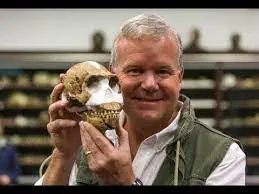Iwo Eleru – The researchers are speculating that fossils found in 2011 in Nigeria, could possibly be members of this mystery species. — DeseretNews, Feb. 18
(Editor’s Note – Cover image Baka in the Forest music available at Amazon.com)
Back in 2011, geneticist Michael Hammer released a National Academy of Sciences paper along with four colleagues,
Genetic evidence for archaic admixture in Africa
 A long-debated question concerns the fate of archaic forms of the genus Homo: did they go extinct without interbreeding with anatomically modern humans, or are their genes present in contemporary populations? This question is typically focused on the genetic contribution of archaic forms outside of Africa. Here we use DNA sequence data gathered from 61 noncoding autosomal regions in a sample of three sub-Saharan African populations (Mandenka, Biaka, and San) to test models of African archaic admixture.
A long-debated question concerns the fate of archaic forms of the genus Homo: did they go extinct without interbreeding with anatomically modern humans, or are their genes present in contemporary populations? This question is typically focused on the genetic contribution of archaic forms outside of Africa. Here we use DNA sequence data gathered from 61 noncoding autosomal regions in a sample of three sub-Saharan African populations (Mandenka, Biaka, and San) to test models of African archaic admixture.
His team hypothesized:
[That an] unusual haplotype descends from an archaic DNA segment that entered the AMH population via admixture.
Also that year, Hammer and his research team at the University of Arizona-Tucson looked into the strange case of Albert Perry, a South Carolina man with an extremely rare Haplo-type AOO.
According the newscientist.com, 2013:
Hammer’s team examined an African database of nearly 6000 Y chromosomes and found similarities between Perry’s and those in samples taken from 11 men, all living in one village in Cameroon. This may indicate where in Africa Perry’s ancestors hailed from…
then some time within the last 195,000 years, anatomically modern humans interbred with an ancient African human.
There is some supporting evidence for this scenario. In 2011, researchers examined human fossils from a Nigerian site called Iwo Eleru. The fossils showed a strange mix of ancient and modern features, which also suggested interbreeding between modern and archaic humans. “The Cameroon village with an unusual genetic signature is right on the border with Nigeria, and Iwo Eleru is not too far away,” says Hammer. [Emphasis added
Joshua Akey at the University of Washington in Seattle and Sarah Tishkoff at the University of Pennsylvania began research into mapping the African genome in 2017/18. Their findings echoed those of Professor Hammer 6 years earlier.
From NewScientist.com, Oct. 10, 2018,
Traces of mystery ancient humans found lurking in our genomes
including the Baka hunter-gatherers from Cameroon, and the Hadza and Sandawe from Tanzania. Within these genomes, they have found stretches of DNA that appear to come from another hominin species. Because this DNA is found only in the descendants of African people – not in any Eurasians – the ghost species must have interbred with H. sapiens after the out-of-Africa migration 60,000 years ago. In fact, by the team’s calculations, this probably happened within the past 30,000 years. If true, this is huge. [Emphasis added]
“The original paper by Durvasula and Sankararaman in Science Advances explicitly mentions Iwo Eleru…” — Jean-Jacques Hublin, Dir. of Human Evolution, Max Plank Inst. Leipzig, Twitter, Feb. 20
Now comes the monumental study by Arun Durvasula and Sriram Sankararaman, February 13, 2020,
Recovering signals of ghost archaic introgression in African populations
 We leveraged whole-genome sequence data from present-day West African populations and archaic hominins to compute statistics that are sensitive to introgression in the history of these populations. Specifically, we tabulated the distribution of the frequencies of derived alleles (where a derived allele is determined relative to an inferred human ancestor) in the analyzed African populations at single-nucleotide polymorphisms (SNPs) for which a randomly sampled allele from an archaic individual was observed to also be derived.
We leveraged whole-genome sequence data from present-day West African populations and archaic hominins to compute statistics that are sensitive to introgression in the history of these populations. Specifically, we tabulated the distribution of the frequencies of derived alleles (where a derived allele is determined relative to an inferred human ancestor) in the analyzed African populations at single-nucleotide polymorphisms (SNPs) for which a randomly sampled allele from an archaic individual was observed to also be derived.
Conclusion summary:
Our analyses provide support for a contribution to the genetic ancestry of present-day West African populations from an archaic ghost population whose divergence from the ancestors of modern humans predates the split of Neanderthals and modern humans.
Their results received big headlines in the NY Times and numerous Scientific media. But way down in their paper, a reference to fossil finds at Iwo Eleru.
From Weather.com, Feb. 13:
According to the Times of India, the UCLA team believes that west Africans and the archaic ghost population interbred with west African ancestors about 50,000 years ago. That correlates with the Iwo Eleru redating.
From the Times of India, Feb. 20:
Here is the precise passage in the research paper, 2nd paragraph, Discussion:
recent fossils with archaic features (or combinations of archaic and modern human features) have been found in the fossil record in Africa and the Middle East. While anatomically modern humans appear in the fossil record around 200,000 years ago, fossils with a combination of archaic and modern features can be found across sub-Saharan Africa and the Middle East until as recently as 35,000 years ago. Examples of these fossils include a cranium from Iwo Eleru…
Did Duvasula and Sankararaman just solve the mystery of AOO haplo type and confirm the reanalyses of the dating of hominid fossils at Iwo Eleru?
More here.



Great content! Super high-quality! Keep it up! 🙂